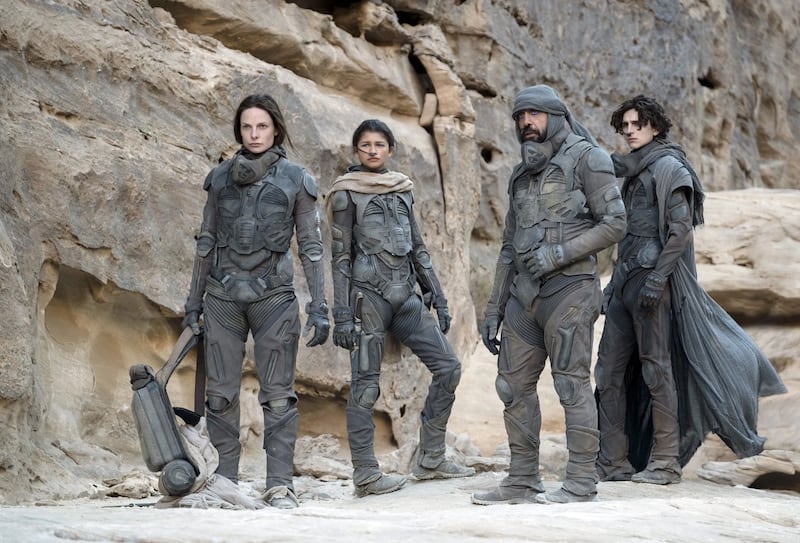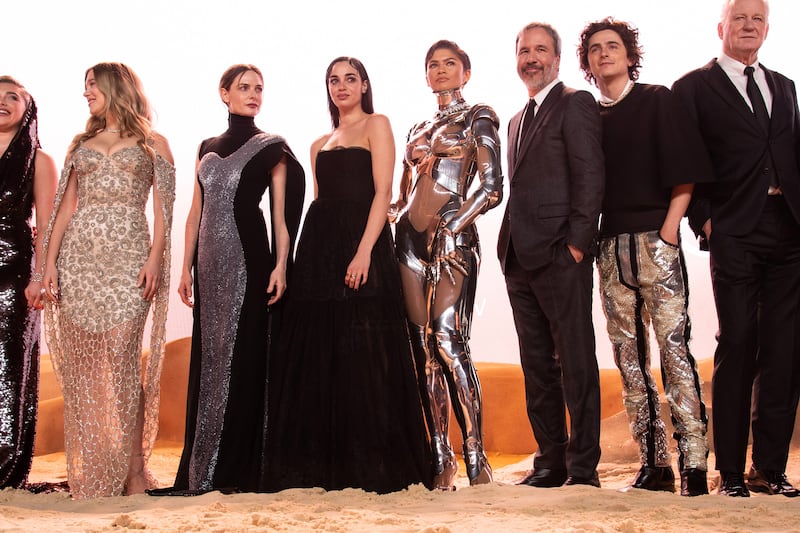Denis Villeneuve has loved science fiction for as long as he can remember. “From when I was very young I loved reading graphic novels from Europe: Moebius and Druillet and Bilall, and Jean-Claude Mézières. These guys are the masters. I owe them everything.” He laughs. “Everybody owes everything to them. Every sci-fi movie owes those artists.”
When Villeneuve was 14 he and his childhood friend Nicolas Kadima started to storyboard a novel they had become obsessed with: Frank Herbert’s Dune. Several panels survive. Their striking juxtaposition of close-ups and vast horizons is not unlike the framing in Dune: Part Two. Today, in London, before that film’s world premiere, the Canadian director acknowledges the continuing influence of those early doodles.
“There are moments in both movies that are very close to the initial dream,” he says. “They are all linked with the Fremen world. There are some shots and, looking at them, I remember weird emotions because I’m very close to them now. But then, because of adaptation, you destroy some things, and you make new things to fit the film format. That’s the challenge of adaptation.”
He remains a fan. When he talks about Dune: Part Two’s exciting opening sequence, in which interlopers elegantly float to the surface of a subjugated desert planet, he sounds like a 56-year-old channelling his inner 14-year-old. “What excited me is that there’s no propulsion system. It’s like pressed gravity,” he says. “It’s from the book. Now, once you don’t have gravity, you must move underwater like a scuba diver. You use inertia. I loved the idea of divers in the desert.”
READ MORE
A quick recap. Herbert’s extravagant act of world-building concerns an intergalactic battle to control “spice”, a mind-altering drug with side effects that include turning its users’ eyes bright blue and, in a trait that comes in handy for interstellar imperialism, enhancing their space-time perception.
By the end of his film of the first part of the story, from 2021, the House Atreides has fallen, forcing the young heir Paul Atreides (Timothée Chalamet) and his mother, Lady Jessica (Rebecca Ferguson), to take refuge among the Fremen, the hardy indigenous people of the planet Arrakis. It’s a significant destination, as it’s the only place where spice, a byproduct of the monstrous sandworms that live there, can be harvested.
As the locals do battle against their would-be colonisers from House Harkonnen – headed by the corpulent Baron Vladimir Harkonnen (Stellan Skarsgård) – newer political players come into view. The conniving House Corrino, including Emperor Shaddam IV (Christopher Walken) and his daughter Princess Irulan (Florence Pugh) lurk in their palace. The baron’s nephew and thuggish henchman Glossu (Dave Bautista) finds a rival brute in the form of Austin Butler’s knife-wielding Feyd-Rautha Harkonnen. Various sisters from the witchy Bene Gesserit religious order, to which Lady Jessica also belongs, skulk around. Their painting of Paul as the Fremens’ Messiah is increasingly concerning for Chani (Zendaya), his Fremen-warrior love interest.
It’s a lot of plot, even for a second instalment that clocks in at 165 minutes but Villeneuve distils the source material into a series of set pieces and a love story. “The most important thing for me is that intimate relationship between Paul and Chani,” says the director. “That’s where all the firepower is in the movie. The whole story is structured on their story. So I wanted to be very close to them.”

When Villeneuve says close, he means it. Working with the cinematographer Greig Fraser, he mirrors Herbert’s micro and macro narratives by alternating grandiose set pieces with intimate profile shots. It’s almost like watching silent cinema. Except on an IMAX scale.
“The book is a very mental book,” says Villeneuve. “You follow the thought processes of the characters. The book is mostly about people’s thoughts and their inner strategies. It’s a very paranoid read. I didn’t want to have a voiceover or hear the characters speaking their thoughts. I wanted the audience to feel what they were thinking. I love the human face. The first [Dune] film was the first time I shot with IMAX. When I finished that movie I felt I had been too shy. With Part Two I wanted to be more extreme. I wanted to be very close to the actors. And then to shoot them like they are ants, from very far away.”
Villeneuve is hardly the first person to fall under the spell of one of the best-selling science-fiction novels ever written. In the 1970s the surrealist Chilean director Alejandro Jodorowsky planned a 15-hour version featuring Orson Welles as Baron Harkonnen, Salvador Dalí as the emperor and Mick Jagger as Feyd-Rautha. Moebius – the French cartoonist Jean Giraud – collaborated with Jodorowsky on more than 3,000 panels for the storyboard. HR Giger, who would later fashion the xenomorphs for Ridley Scott’s film Alien, went to work on designs for the Harkonnen castle. Pink Floyd and Magma were approached for the soundtrack.
David Lynch’s starry 1984 film demonstrated that Dune was not, as previously held, “unfilmable”. Though pummelled by American critics and disowned by its director, the film fared better in Europe, where it has a cult following. The English critic Derek Malcolm described it at the time as a “long, slow, often majestically visualised approximation of Herbert’s magnum corpus, with every effect carefully thought out and brilliantly decorated with endless detail”.
Two television miniseries – Dune, in 2000, and Children of Dune, in 2003 – have subsequently been added to Dune’s screen canon. But we’re forgetting something.
“Star Wars!” says Villeneuve. “One could say that Star Wars is an interesting Dune adaptation – and all the comic books that Jodorowsky made afterwards. All these Dune projects are very different. I made my adaptation focusing exclusively on the book. I didn’t think about anything else that had been made. I just wanted to pay homage to Frank Herbert. Of course, there’s Jon Spaihts, who I worked with on the screenplay, and Hans Zimmer, who is a massive Dune fan. But nobody questioned my interpretation of the book. That’s my responsibility. If someone doesn’t like this adaptation, there’s only one person to blame.”
It’s tricky to reconcile Villeneuve’s early low-key films, which include the wacky 1998 romcom August 32nd on Earth and Maelstrom, a murder comedy narrated by a dying fish, with the director that he would become. He likens his career to earning ever more senior martial-arts belts. Hollywood came calling after Incendies, an absorbing drama from 2010 about two Canadian siblings who travel to the Middle East in search of estranged family. Prisoners, the 2013 hit starring Hugh Jackman as the vengeful dad of a missing child, led to the Oscar-nominated drug-cartel thriller Sicario, which led to the exquisite alien-contact drama Arrival, which led to Blade Runner 2049.
Villeneuve doesn’t miss the hard scrabble of the indie world. “When you have the firepower for Blade Runner or Dune, you can get very very close to the movie that is in your mind,” he says. “There are a lot of scenes or sequences that are exactly the way I want. When I see them I get chills. No matter how people react, it feels good, because it was exactly what I intended. It’s honest.”
[ Dune: A pretty but ponderous start to a lengthy epicOpens in new window ]
Dune: Part Two is “a warning about heroes and a warning about the blending of religion and politics”. Villeneuve’s second instalment leans heavily into the tragic aspects of Herbert’s book, gesturing towards Dune Messiah, the second of Frank Herbert’s sextet of novels. As recently as last summer Villeneuve was expected to direct this possible continuation. “If I succeed in making a trilogy, that would be the dream,” he said then. “Part Three would consist of Dune Messiah, Herbert’s direct follow-up to Dune. Dune Messiah was written in reaction to the fact that people perceived Paul Atreides as a hero, which is not what he wanted to do.”

Today, the director, who is attached to adaptations of Arthur C Clarke’s Rendezvous with Rama and of Stacy Schiff’s biography of Cleopatra, seems a little less certain about a trilogy. And who could blame him? The Dune saga is monstrous. In addition to the six books in Herbert’s original series, there are 20 more novels co-written by Herbert’s son, Brian, and Kevin J Anderson, not to mention the short stories, poetry and board games.
“When I finished Part Two I had a very strong emotion,” Villeneuve says. “Okay. That was a journey. I feel that there could be a possibility to move back a third time. That’s in the works. But I spent the last six years on Dune, and there’s a lot of other stories I would love to do. I don’t know how James Cameron tells himself, ‘I’m going to spend the next 15 or 20 years doing one thing.’ I’m not sure I can do that. Cinema is creativity and risk. My other projects are challenges, and that brings joy to my heart. It’s a little bit of a Don Quixote approach. But I love Don Quixote.”
Dune: Part Two opens on Friday, March 1st


















